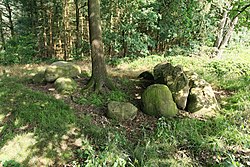Great stone graves near Spahn
| Great stone graves near Spahn Hünenstein, Steenberg | ||
|---|---|---|
|
Great stone grave Spahn 1 |
||
|
|
||
| Coordinates | 52 ° 52 '5 " N , 7 ° 34' 5" E | |
| place | Spahnharrenstätte , Lower Saxony , Germany | |
| Emergence | 3500 to 2800 BC Chr. | |
| Sprockhoff no. | 827-828 | |
The large stone graves at Spahn are two between 3500 and 2800 BC. Resulting Chr. Megalithic the Neolithic Funnel Beaker Culture (TBK) in the municipality Spahnharrenstätte belonging district Spahn in Emsland ( Lower Saxony ). A third grave was destroyed in the early 19th century. Grave 1 is also known under the name Hünenstein and has the Sprockhoff number 827. Grave 2 is also known as Steenberg and has the number 828.
location
Grave 1 is located 1 km northwest of Spahnharrenstätte on the Zum Windberg road. A little south of it was the destroyed third grave. Grave 2 is 1.7 km northeast of grave 2 and 1.4 km north of Spahn. The Männige Berge burial mound is located 1.2 km north of grave 1 .
description
The preserved grave 1
The Hünenstein has a flat mound with a length of 17 m and a width of 15 m. There is an east-west oriented burial chamber with a length of 4.5 m and a width of 2.2 m. In its original state, it had four pairs of wall stones on the long sides, one end stone each on the narrow sides and three cap stones. Only the two end stones are left in situ . On the long sides, two wall stones have been preserved, none of which are in their original position. Of the capstones, only the one to the east is still there. He fell into the chamber.
The preserved grave 2
The Steenberg has an oval, west-northwest-east-south-east oriented mound with a length of 30 m and a width of 10 m. Remains of the stone enclosure are only preserved in the south and west. According to the reconstruction by Ernst Sprockhoff, the burial chamber in its original state had 15 wall stones on the northern long side, 14 on the southern, one end stone each on the narrow sides, 14 cap stones and a corridor on the middle of the south side, made up of four pairs of wall stones and three cap stones duration. The chamber is thus to be addressed as a passage grave. Their degree of destruction is quite high. Most of the wall stones in the chamber are missing and most of the remaining stones are no longer in their original position. Eleven capstones are still preserved. But they were partially blown up and all fell into the interior of the chamber. Four wall stones from the corridor have survived, the two outer ones in situ. The cap stones are missing.
The destroyed grave 3
The third grave is only known from a report by Heinrich Bödiker who visited it in 1825. Just a few years later it seems to have been completely destroyed, as Johann Karl Wächter did not mention it again in 1841. During his examination, Bödiker found several wall stones and a cap stone resting on them. Several more capstones had already been removed.
literature
- Heinrich Bödiker: Antiquities in the Meppen office. In: Wigand's archive for history and antiquity. Volume 2, 1827, pp. 176, 178.
- Johannes Heinrich Müller, Jacobus Reimers: Pre and early historical antiquities of the province of Hanover. Schulze, Hannover 1893, 243–244 ( PDF; 25.0 MB ).
- Ernst Sprockhoff : Atlas of the megalithic tombs of Germany. Part 3: Lower Saxony - Westphalia. Rudolf-Habelt Verlag, Bonn 1975, ISBN 3-7749-1326-9 , p. 93.
- Johann Karl Wächter : Statistics of the pagan monuments existing in the kingdom of Hanover. Historical Association for Lower Saxony, Hanover 1841, p. 139.


